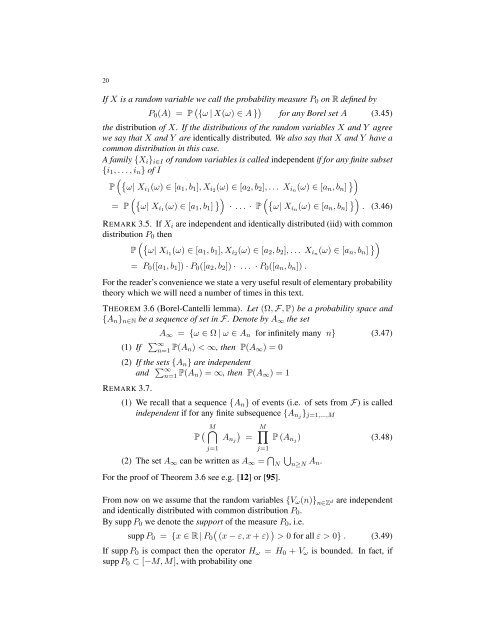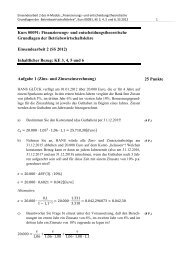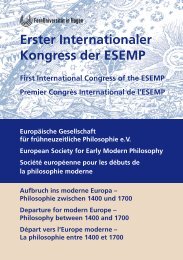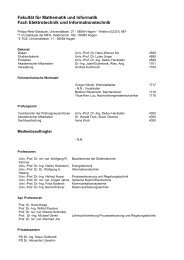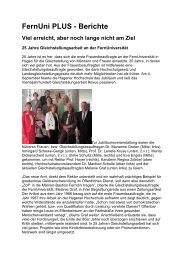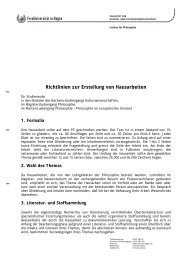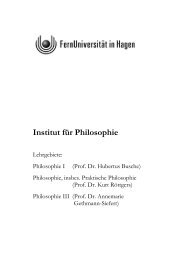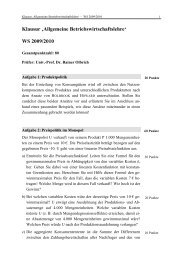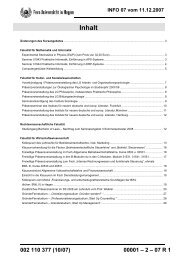An Invitation to Random Schr¨odinger operators - FernUniversität in ...
An Invitation to Random Schr¨odinger operators - FernUniversität in ...
An Invitation to Random Schr¨odinger operators - FernUniversität in ...
Create successful ePaper yourself
Turn your PDF publications into a flip-book with our unique Google optimized e-Paper software.
20<br />
If X is a random variable we call the probability measure P 0 on R def<strong>in</strong>ed by<br />
P 0 (A) = P ( {ω | X(ω) ∈ A } ) for any Borel set A (3.45)<br />
the distribution of X. If the distributions of the random variables X and Y agree<br />
we say that X and Y are identically distributed. We also say that X and Y have a<br />
common distribution <strong>in</strong> this case.<br />
A family {X i } i∈I of random variables is called <strong>in</strong>dependent if for any f<strong>in</strong>ite subset<br />
{i 1 , . . . , i n } of I<br />
( {ω|<br />
P Xi1 (ω) ∈ [a 1 , b 1 ], X i2 (ω) ∈ [a 2 , b 2 ], . . . X <strong>in</strong> (ω) ∈ [a n , b n ] })<br />
= P<br />
( {ω|<br />
Xi1 (ω) ∈ [a 1 , b 1 ] }) · . . . · P<br />
( {ω|<br />
X<strong>in</strong> (ω) ∈ [a n , b n ] }) . (3.46)<br />
REMARK 3.5. If X i are <strong>in</strong>dependent and identically distributed (iid) with common<br />
distribution P 0 then<br />
( {ω|<br />
P Xi1 (ω) ∈ [a 1 , b 1 ], X i2 (ω) ∈ [a 2 , b 2 ], . . . X <strong>in</strong> (ω) ∈ [a n , b n ] })<br />
= P 0 ([a 1 , b 1 ]) · P 0 ([a 2 , b 2 ]) · . . . · P 0 ([a n , b n ]) .<br />
For the reader’s convenience we state a very useful result of elementary probability<br />
theory which we will need a number of times <strong>in</strong> this text.<br />
THEOREM 3.6 (Borel-Cantelli lemma). Let (Ω, F, P) be a probability space and<br />
{A n } n∈N be a sequence of set <strong>in</strong> F. Denote by A ∞ the set<br />
(1) If<br />
A ∞ = {ω ∈ Ω | ω ∈ A n for <strong>in</strong>f<strong>in</strong>itely many n} (3.47)<br />
∑ ∞<br />
n=1 P(A n) < ∞, then P(A ∞ ) = 0<br />
(2) If the sets {A n } are <strong>in</strong>dependent<br />
and ∑ ∞<br />
n=1 P(A n) = ∞, then P(A ∞ ) = 1<br />
REMARK 3.7.<br />
(1) We recall that a sequence {A n } of events (i.e. of sets from F) is called<br />
<strong>in</strong>dependent if for any f<strong>in</strong>ite subsequence {A nj } j=1,...,M<br />
P ( M ⋂<br />
j=1<br />
A nj<br />
)<br />
=<br />
M ∏<br />
j=1<br />
(2) The set A ∞ can be written as A ∞ = ⋂ N<br />
For the proof of Theorem 3.6 see e.g. [12] or [95].<br />
P (A nj ) (3.48)<br />
⋃<br />
n≥N A n.<br />
From now on we assume that the random variables {V ω (n)} n∈Z d are <strong>in</strong>dependent<br />
and identically distributed with common distribution P 0 .<br />
By supp P 0 we denote the support of the measure P 0 , i.e.<br />
supp P 0 = {x ∈ R | P 0<br />
(<br />
(x − ε, x + ε)<br />
)<br />
> 0 for all ε > 0} . (3.49)<br />
If supp P 0 is compact then the opera<strong>to</strong>r H ω = H 0 + V ω is bounded. In fact, if<br />
supp P 0 ⊂ [−M, M], with probability one


